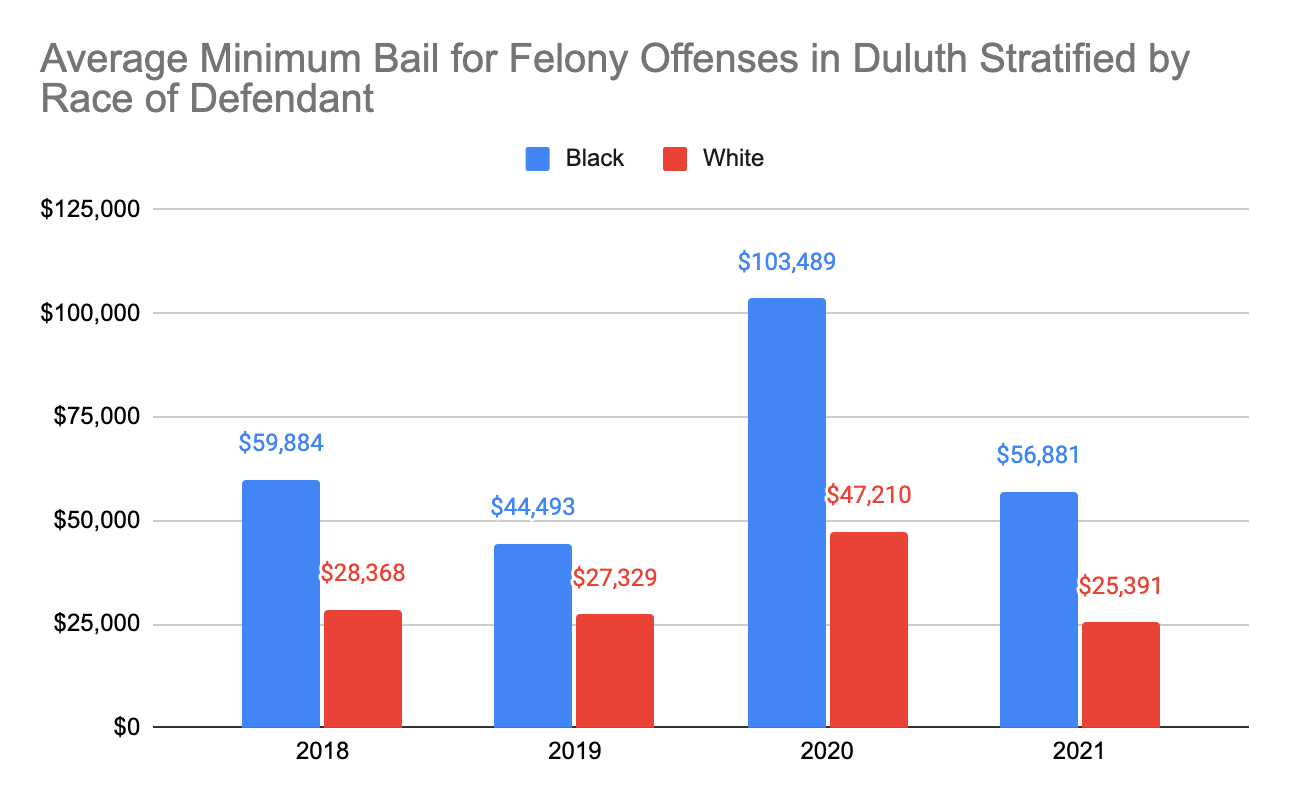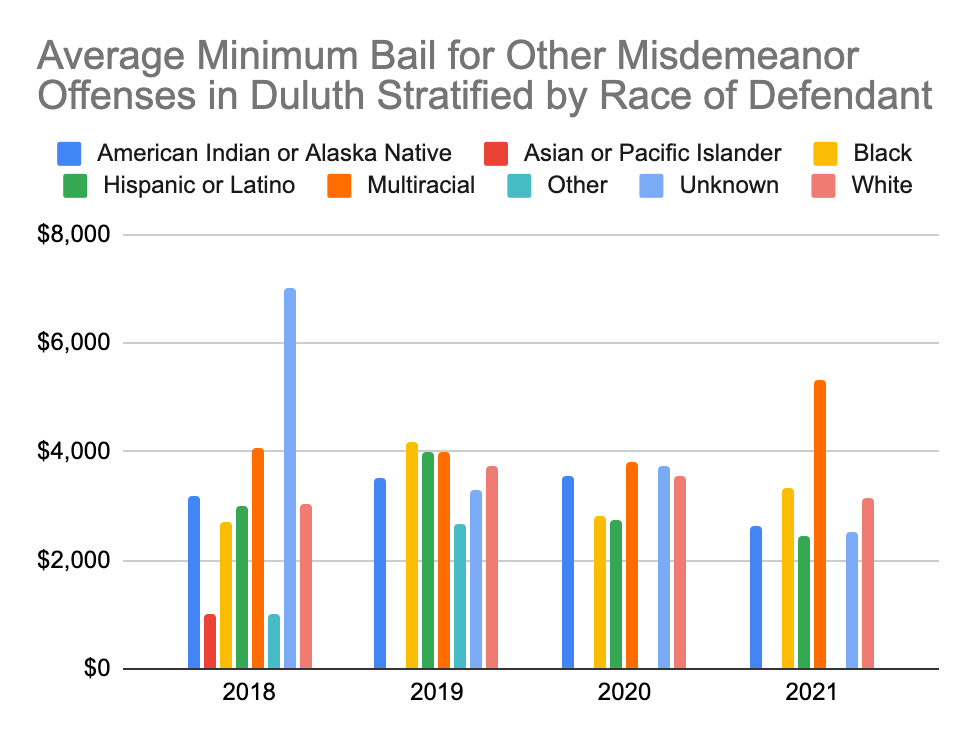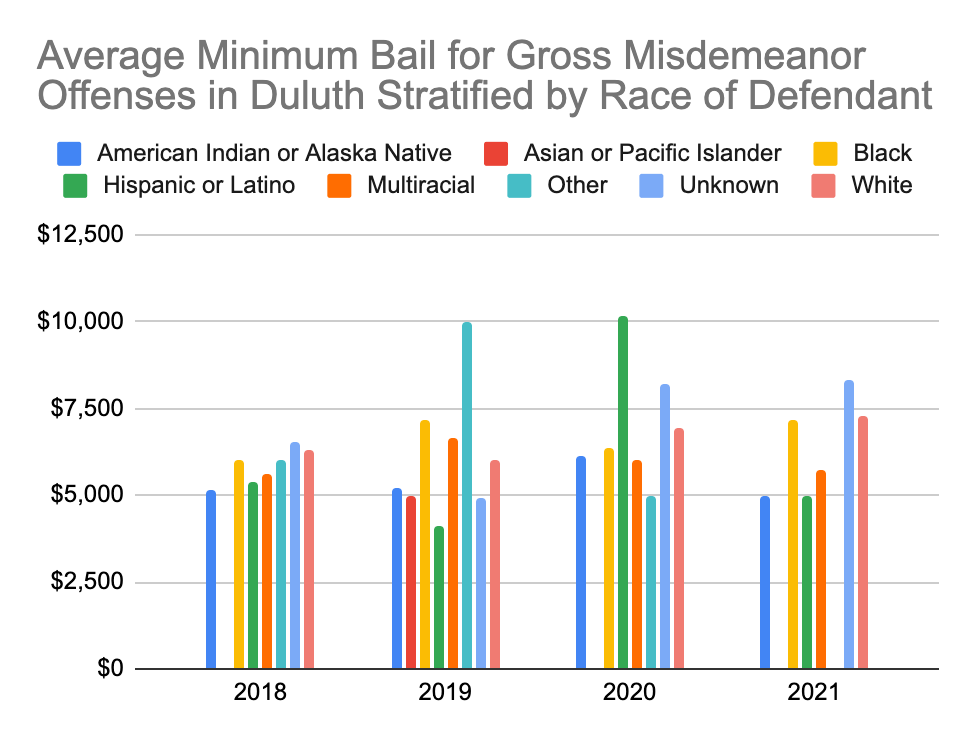
Fig. 1. Average minimum bail for felony offenses stratified by race of defendant (white or Black) and case year. Data accounts for 1,373 cases filed from January 1, 2018 to December 31, 2021 in Duluth, MN.
The above analysis of average minimum bail for felony offenses was performed with a larger dataset including felony, gross misdemeanors, and other misdemeanors with a mandated court date. The data was released by the Minnesota Court Administrator’s Office to the Duluth Branch NAACP as a public data request on February 11, 2022, and was subsequently shared with the Law Enforcement Accountability Network (LEAN) Duluth for analysis.
All data points are based on the initial bail/bond ordered on the case. Subsequent orders may have imposed different pretrial conditions and/or non-monetary conditions that are not represented in this study. In cases that included multiple alternative conditions, the minimum dollar amount is used to generate the average bail or bond amount. Offense levels are based on the most serious charge on the case, using Judicial Weighted Caseload categories. The race of the defendant was determined using the self-reported race that is requested during a court appearance.
For felony charges, Black defendants received higher bail on average than white defendants (Fig. 1). When accounting for all years, Black defendants received an average bail of $66,186 for felony charges, over twice the average bail of $32,074 for white defendants.
Stratification of the larger dataset by all reported races (Fig. 2) does not show reliable disparities between white defendants and other racial groups. However, this analysis is limited by the small sample size of Asian/Pacific Islander, Latino/Hispanic, and multi-racial cases during the time period.

Fig. 2. Average minimum bail for felony offenses stratified by race of defendant and case year. Larger dataset includes all racial categories collected by courts. Data accounts for 1,619 cases filed from January 1, 2018 to December 31, 2021 in Duluth, MN.
Notably, the “Unknown” racial category shows significantly higher bails, but this category accounts for a nominal number of total cases throughout the time period (Fig. 3). Furthermore, stratification of total case numbers by race shows disparity when accounting for the census data and regional demographics of the city. While Black people only make up 2.3% of Duluth’s population, cases with Black defendants made up 20% of felony cases requiring bail. Similarly, American Indian/Alaska Natives only make up 1.8% of Duluth’s population, but disparately account for 16% of felony cases requiring bail.

Fig. 3. Duluth felony charges that required bail stratified by race, juxtaposed by Duluth census population estimates as of July 1, 2021. Data accounts for 1,619 cases filed from January 1, 2018 to December 31, 2021 in Duluth, MN.
Analysis of average minimum bail for gross misdemeanor and misdemeanor cases requiring court appearance (Fig. 4A, Fig. 4B) did not produce notable disparities between Black and white defendants. When accounting for 2018-2021, Black defendants received an average bail of $6,679 for gross misdemeanors, in comparison to $6,627 for white defendants. Black defendants received an average bail of $3,260 for misdemeanors requiring court appearances, in comparison to $3,374 for white defendants.


Fig. 4A. Average minimum bail for gross misdemeanor offenses stratified by race of defendant. Data accounts for 755 cases filed from January 1, 2018 to December 31, 2021 in Duluth, MN; Fig. 4B. Average minimum bail for other misdemeanor offenses with mandatory court appearance stratified by race of defendant. Data accounts for 724 cases filed from January 1, 2018 to December 31, 2021 in Duluth, MN
Discussion
Cash bail is used to ensure that a defendant will return for court appearances. The money is returned after the defendant makes all necessary court appearances; otherwise the bail is forfeited to the government. As the
Minnesota Freedom Fund states on their website, "Cash bail is an abusive system that criminalizes poverty and takes a disproportionate toll on Black people, Indigenous people, and people of color."
The disparities in Duluth data fit into these larger trends of racial disparities in the criminal justice system. These findings provide an additional perspective to
LEAN’s May 2021 data analysis that showed racially disparate sentencing for drug charges in St. Louis County in 2020.
Not only are Black members of the community more likely to spend additional time in prison for the same crime when compared to their white counterparts, but their average cost to get out of pre-trial detention is nearly twice the average for white people. More days spent in pre-trial detention can lead to loss of work and income, and sometimes
long-term financial consequences. In addition, numerous studies suggest that people who spend time in pre-trial detention are more likely to be convicted and to receive
harsher sentences.
Felonies are one of the main drivers of mass incarceration nationwide. As incarceration expert Dr. David Harding explains, “Mass incarceration was accompanied by a vast increase in the number of people convicted of felonies – during a time when arrests for serious crimes were flat or falling in most states. Between 1980 and 2010, the number of Americans with a felony record increased almost fourfold, from just under 5 million to over 19 million, according to new estimates. The main driver of this increase is a greater likelihood that an individual with an arrest will be charged by prosecutors with a felony.” Thus, racial disparities present within the Duluth bail system for felonies and not gross misdemeanors and misdemeanors with mandatory court dates further exemplify the nuanced role that the felony conviction plays in local systems of oppression.
Additional research is needed to examine the role and biases of individual judges in creating these disparities, and the long-term oppressive effects that racially disparate cash bail has on our community. While this study identifies racial disparities in the current system, it leaves many questions unanswered. Are higher bails a result of Black defendants being disproportionately charged with more severe felonies? Do higher criminal history scores due to racially disparate policing contribute to higher bail amounts? Are Black defendants being charged higher bail amounts than white defendants with comparable crime severity and criminal history scores? We strongly encourage community organizations and officials within the justice system to ask these challenging questions with the hope of addressing these disparities in a way that will ultimately lead to equitable change.